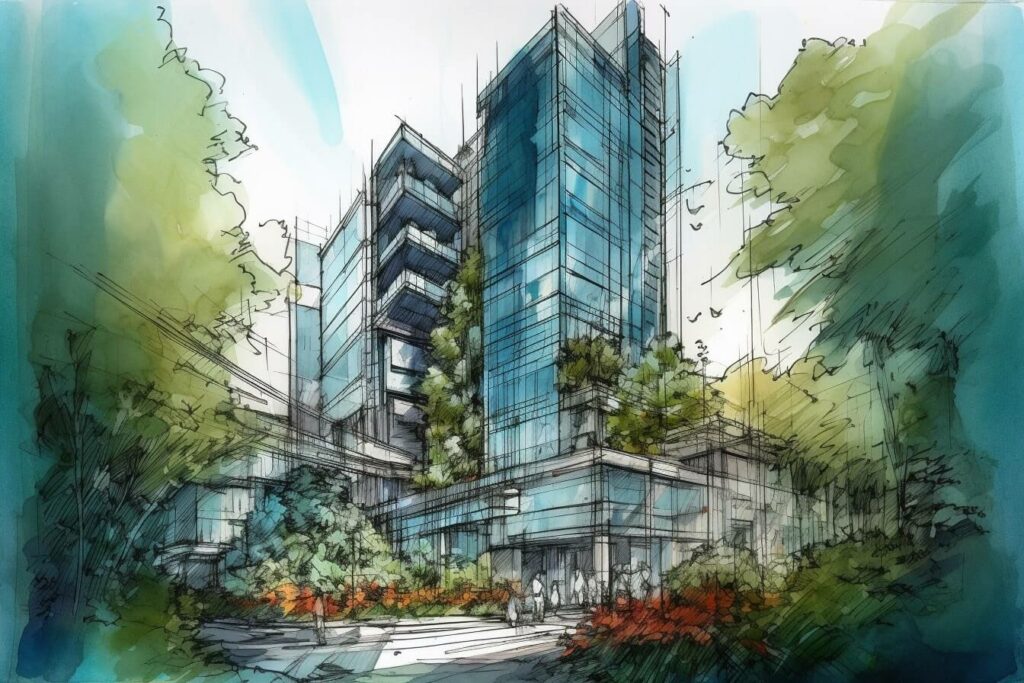
Sustainability has become an essential factor in the construction industry due to the impact of buildings on the environment. Buildings are responsible for a significant portion of energy consumption and greenhouse gas emissions, making them a critical area of focus for sustainability efforts. Consequently, there is an increasing demand for environmentally friendly buildings that are energy-efficient, sustainable, and have a minimal environmental impact.
LEED certification has emerged as a popular way for buildings to demonstrate their commitment to sustainability. LEED certification is recognized globally as a certification program that independently verifies a building’s environmental performance.
The certification recognizes buildings designed and built using strategies to achieve high performance in critical human and environmental health areas, such as sustainable site development, water savings, energy efficiency, materials selection, and indoor environmental quality.
As the demand for environmentally friendly buildings continues to increase, so does the interest in LEED certification. However, many people are unsure about the costs of obtaining LEED certification and how to keep those costs down. In this article, we will break down the costs associated with LEED certification and provide tips to help you keep those costs under control.
LEED certification is a rating system developed by the United States Green Building Council (USGBC) to encourage sustainable design and building practices. LEED stands for Leadership in Energy and Environmental Design. It is a globally recognized certification program that provides independent verification that a building was designed and built using strategies to achieve high performance in critical human and environmental health areas.
The LEED certification process is based on a point system that evaluates a building’s sustainability across several categories, including sustainable site development, water efficiency, energy and atmosphere, materials and resources, indoor environmental quality, innovation, and regional priority. Each category is assigned a certain number of points, and a building must earn a minimum number of points to achieve certification. The levels of certification are Certified, Silver, Gold, and Platinum, with Platinum being the highest level of certification.
LEED certification is a voluntary program, and buildings can pursue certification for new construction, existing buildings, commercial interiors, and homes. The certification process involves documentation and verification by a third-party organization, which ensures that the building meets the rigorous sustainability standards set by the USGBC.
In addition to demonstrating a building’s commitment to sustainability, LEED certification offers several benefits, including improved energy efficiency, reduced environmental impact, improved indoor air quality, and increased property value. It also helps building owners and operators save money on operating costs, as sustainable buildings are generally more energy-efficient and have lower maintenance costs over time.
Overall, LEED certification is an essential tool for promoting sustainable building practices and reducing the environmental impact of buildings. By providing independent verification of a building’s sustainability, LEED certification helps to building owners and operators demonstrate their commitment to sustainability while reaping the benefits of reduced operating costs and increased property value.

When pursuing LEED certification, several costs need to be taken into account. The cost of certification can vary widely depending on the building type, the project size, and the certification level you seek. Here are the different costs that you need to consider:
The registration fee is the first cost you will incur when pursuing LEED certification. This fee is based on the project size and the building type.
The fee ranges from $1,200 to $2,750 for new construction projects and from $900 to $1,750 for existing buildings. This fee is paid upfront to register your project with the USGBC and initiate the certification process.
Once you have registered your project, you must pay the certification fee. This fee is based on the size of the project and the level of certification you are seeking.
The fee ranges from $2,500 to $22,000 for new construction projects and from $1,750 to $15,000 for existing buildings. This fee is paid after your project has been reviewed and verified by the USGBC and is awarded certification.
To achieve LEED certification, you will likely need to hire a consultant to help guide you through the process. The consultant fees can vary widely depending on the size and complexity of the project, as well as the consultant’s experience and expertise.
On average, consultant fees can range from $10,000 to $30,000. However, hiring a consultant can help you identify cost-saving opportunities and avoid costly mistakes, ultimately reducing the overall certification cost.
An independent third party must test and verify your building to achieve LEED certification. The testing and verification fees can range from $1,000 to $10,000, depending on the size and complexity of the project.
These fees cover the cost of site visits and testing to verify that your building meets the sustainability requirements for certification.
Additional costs may be associated with LEED certification, such as upgrading equipment or systems to meet LEED requirements. These costs vary widely depending on the building and the certification level you seek.
However, implementing sustainable features can result in long-term cost savings, such as reduced energy and water consumption, which can offset the initial costs of upgrading equipment or systems.
Overall, the cost of LEED certification can be significant, especially for larger and more complex projects. However, you can achieve LEED certification without breaking the bank by carefully considering the costs and keeping them down, such as hiring an experienced consultant and implementing cost-effective, sustainable features.